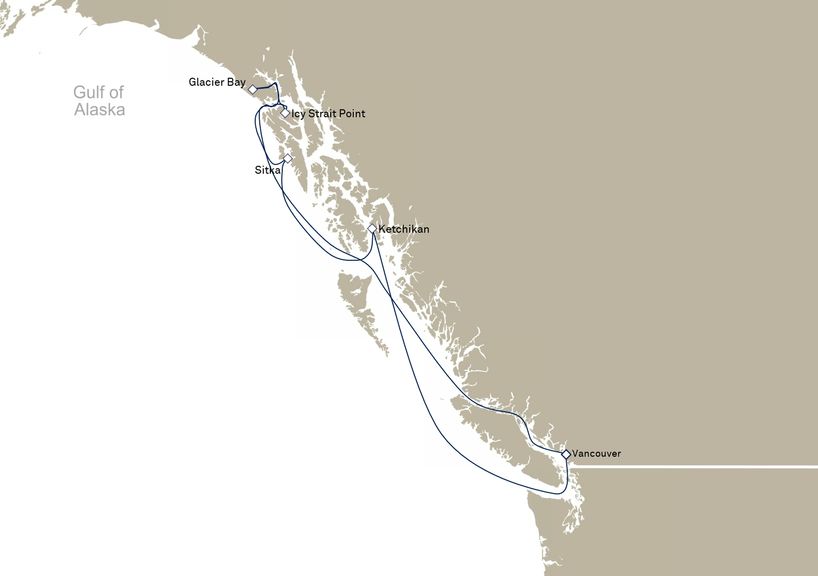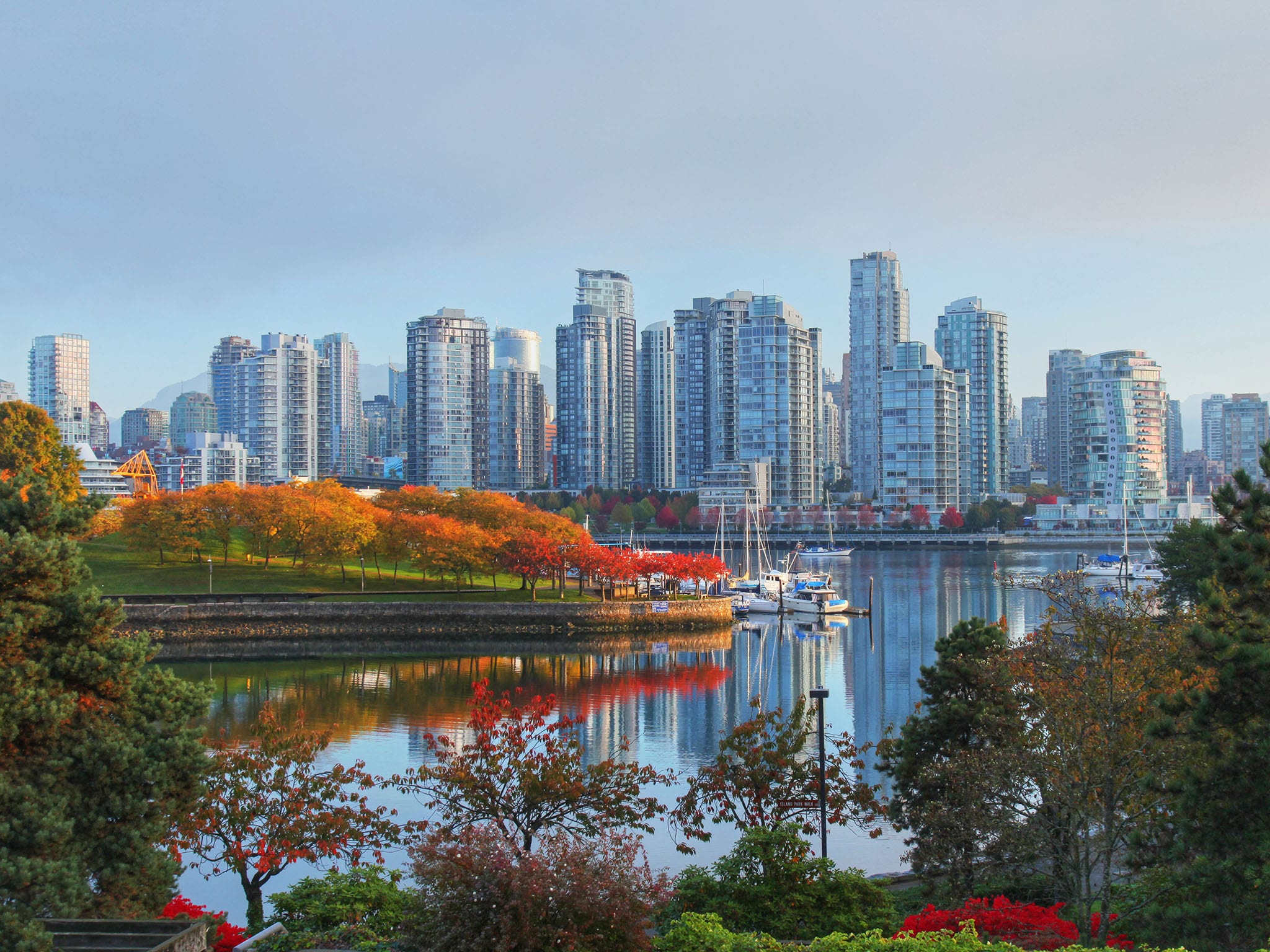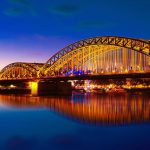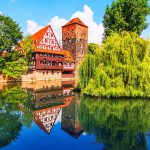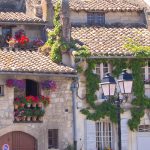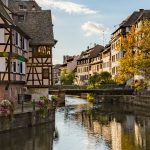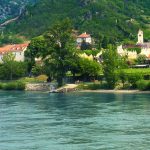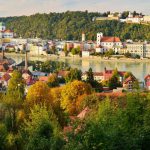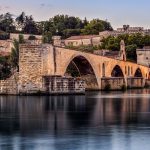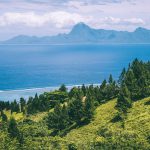Days7 Nights
5 Ports
2 Sea Days
Overnights
Glacier Bay National Park
Days7 Nights
5 Ports
2 Sea Days
Overnights
Glacier Bay National Park
Inclusions
- Cruise-Only Fare
- Roundtrip Air*
(Vancouver & Toronto gateways) - FREE up to $300 Shipboard Credit (per cabin)
- FREE Pre-paid Gratuities
(Value of C$30-$35/Couple/Day) - FREE WiFi
- FREE (1) Specialty Dining ( Dinners)
- FREE Drinks
(Including spirits, international beers & wines. Bottled water, soft drinks, coffee and tea)
- Taxes & Fees Included
- PLUS Travel Insurance‡
Trip Cancellation & Interruption
(for Club Balcony & Higher)
PRE-EXISTING CONDITION WAIVED
NO MEDICAL QUESTIONNAIRE
See: Insurance Coverage Summary / Resolution Policy
| Stateroom (All Balcony Suites) | Sale Fare
(from / per person) |
Savings
(up to / per couple) |
Extra Shipboard Credit | ||
|---|---|---|---|---|---|

|
INSIDE
A sumptuous king-sized bed and a bottle of sparkling wine to welcome you on board. |
$760 $ + $289 Taxes & Fees |
$ | $
per stateroom |
|

|
OCEANVIEW
Awaken each day to glorious natural daylight and a window overlooking the ocean. |
$889 $ + $289 Taxes & Fees |
$ | $
per stateroom |
|

|
BALCONY
Drink in the outside air with your own private balcony adjoined to your Britannia Stateroom. |
$1,149 $ + $289 Taxes & Fees |
$ | $
per stateroom |
|

|
CLUB BALCONY
|
$3,189 $ + $289 Taxes & Fees |
$ | $
per stateroom |
|
| PRICE-VALUE COMPARISON | |||||
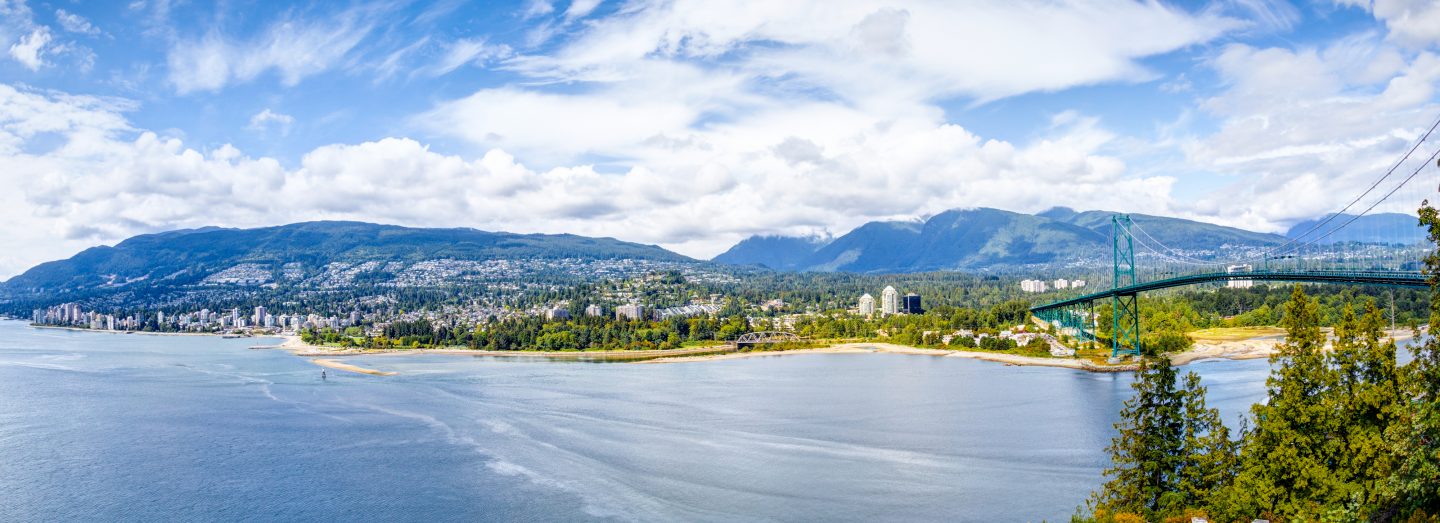
Top landmarks and sights in Vancouver.
From characterful neighborhoods like Gastown and Chinatown, to Stanley Park and the Capilano Suspension Bridge, Vancouver offers a dynamic blend of cultural and natural treasures to explore. You’ll find impressive feats of architecture and engineering, as well as adrenaline-fueled experiences to set your pulse racing.
A walk through Stanley Park is an absolute must. The 1,000-acre space is an oasis in every sense of the world, and the city’s number one attraction. Created in 1888, Stanley Park is unlike anything you’ve experienced, combining rainforest, beaches and historic landmarks with walking trails, ambient restaurants and an aquarium offering countless species of exotic fish.
In North Vancouver, The Capilano Suspension Bridge and the Grouse Mountain are among the top landmarks to seek out. The bridge snakes a 140-meter route through the treetops, 85-meters above the Capilano River. The scenery is magnificent and the experience truly unique.
Grouse Mountain, just 15-minutes from Vancouver downtown, offers an abundance of year-round attractions. Take the Skyride, North America’s largest aerial tramway, to the summit for alpine shopping, mountainside dining and ranger talks at the Refuge for Endangered Wildlife.
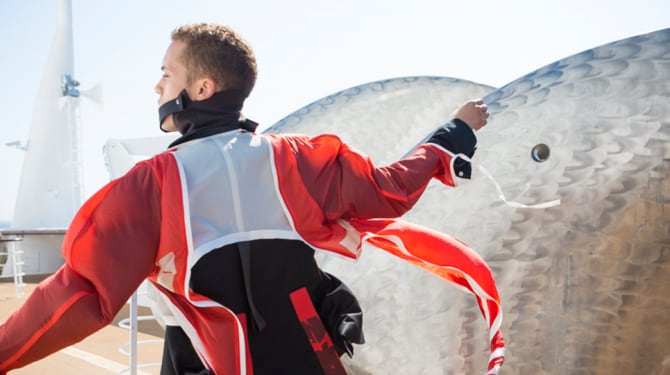
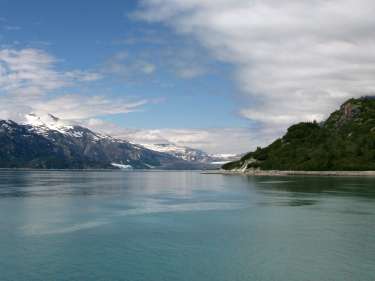
Glacier Bay National Park Port Guide.
Spanning 3.3 million acres, as part of a 25-million-acre World Heritage Site, a Glacier Bay National Park cruise reveals some of the planet’s most remarkable tidewater glaciers.
Top landmarks and sights in Glacier Bay National Park.
There’s so much to take in on a Glacier Bay National Park cruise, it’s hard to know where to begin. Towering mountains, gargantuan icebergs and majestic glaciers stretch as far as the eye can see, disappearing onto the horizon in every direction. It’s a thrilling sight to experience from the deck of a cruise ship, or snuggled under a blanket in the warmth of your stateroom balcony, as you silently watch the world go by.
The park is home to over 1,000 glaciers, the majority of which nestle in the surrounding mountains, connecting land to sky like nature’s skyscrapers. Soaring to 15,000 feet, Glacier Bay’s ranges are the highest coastal peaks in all the world; their abundant snowfall offering the perfect breeding ground for glaciers to take shape.
One of the highlights of visiting Glacier Bay National Park is watching the prolific calving of these shimmering ice giants. Towering hundreds of feet above the water and stretching a hundred feet below, huge jagged pinnacles of ice break off in thunderous explosions, creating flotillas of icebergs. It is an awe-inspiring spectacle.
Things to do in Glacier Bay National Park, Alaska.
There’s a reason cruising is considered the best way to explore Glacier Bay National Park. With dense rainforest, minimal trails (and even fewer roads), Glacier Bay’s natural waters offer the greatest access to the National Park’s awaiting treasures.
Besides the tidal glaciers, for which Glacier Bay National Park is renowned, the area is also a vibrant habitat for a rich variety of wildlife. Massive, spouting humpback whales are often spotted breaching and slapping their tails, as pods of orcas silently glide by and huge Steller sea lions bask in the sun on rocky outcrops. As you sail along the endless miles of pristine coastline, you may see brown bears, mountain goats, and moose, while the sky is filled with hundreds of bird species, including rare puffins and majestic bald eagles.
To further enrich your experience of this wilderness sanctuary, National Park Service rangers will join you on board and offer deeper insight into this fascinating region. They will present you with a host of fascinating facts about the spectacular scenery, glaciers, and wildlife you will see, and inform you about some of the conservation efforts that go on behind the scenes. They will also be on hand to answer any questions you may have about this important biosphere reserve.
Glacier Bay National Park culture and history.
It’s not just travelers who are fascinated by Glacier Bay National Park . Over the years naturalists, scientists and preservationists have all made the pilgrimage here, as equally enamored by the secrets Glacier Bay National Park keeps as the stories it has to tell.
As recently as 200 hundred years ago, the entire area was covered by ice, some 20 miles wide and 4,000 feet thick, as documented by Captain George Vancouver when he discovered the bay (then just a Glacier) in 1794. When naturalist John Muir arrived in 1879 it was a different story. The ice had retreated and he was able to navigate Glacier Bay by Canoe. Muir was captivated by the otherworldliness of the scenery he encountered and changed perceptions of Alaska as a place of desolate isolation to one of incomparable beauty.
It was scientist, William S. Cooper, however, who petitioned for Glacier Bay to be granted protected status, when he visited to conduct a series of plant studies in 1916. Overcome by its untamed wildness, he believed nature should be left to its own devices here, and in 1925 Glacier Bay became a national monument. Fifty years on, then-US-President, Jimmy Carter, signed the Alaska National Interests Lands Conservation Act, cementing Glacier Bay as the National Park and preserve we now know it as today.
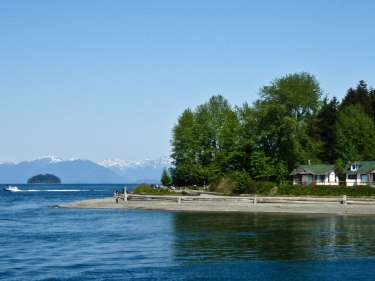
Icy Strait Point port guide.
Picture Alaska and you’ve more or less conjured Icy Strait Point. This natively owned cruise port on Chichagof Island offers the best of what makes this region unique; piercing blue waters, emerald green forest and myriad ways to enjoy the outdoors.
You may decide to spend the afternoon whale watching, join a fishing expedition or take in the scenery on a guided kayaking experience. Then there are the nature hikes, offering the chance to spot native brown bears and eagles in their natural habitat. For the truly brave, Icy Strait Point is also home to the world’s largest zip rider, which propels you over 5,000 feet from a 1,300 vertical drop. It is an adrenaline-fueled experience, perhaps not one for everyone, but definitely something you won’t forget in a hurry.
Of course, there’s much for the leisurely paced visitor to enjoy on shore too. Icy Strait Point is situated just outside Hoonah, the largest Tlingit village in the world. Near to the cruise port, you’ll also find quaint shops selling local artifacts and insightful museums expanding on local history. While along the waterfront a smattering of restaurants are ready to treat you to the freshest crab plucked from Icy Strait bay, an Alaskan delicacy you won’t want to miss.
Top landmarks and sights in Icy Strait Point.
A port call to Icy Strait Point means a choice between whether to spend your time on land, sea or in the air. The island is a natural playground; its waters as dense with whales as its forest is with brown bears.
If you harbor a desire to see either, now’s your chance. So abundant is the population here that tour guides as good as guarantee a sighting. In fact, Icy Strait Point even has its own resident whale who bucks the migration trend to stay put year-round. Nicknamed Freddy by locals, the sight of his colossal tail rising from the water or spray shooting skyward is a common sight on a port call here.
Icy Strait Point’s other claim to fame is its ZipRider, hailed as the largest zip line in the world. The descent takes you from Mount Hoonah’s summit at speeds of 60 miles per hour as the rainforest rushes by below. If you can keep your eyes open for the experience you’ll be treated to stunning views out to the bay as you descend from the mountaintop towards your beach landing.
Things to do in Icy Strait Point Alaska.
Icy Strait Point has any amount of activities to create outstanding memories. Explore the Spaaski River Valley, learn about the history and heritage of Alaska’s native Tlingit people on a tour of Hoonah village, or take a flight-seeing excursion over the UNESCO World Heritage site of Glacier Bay.
Besides its brown bear population, Chichagof Island is abound with wildlife, including Sitka black-tail deer, red squirrels, bald eagles and land otters. Discover this side of Icy Strait Point on an ATV or Jeep tour through the island’s old logging roads or take a helicopter ride to see the area’s outstanding natural beauty from a bird’s eye view.
The charming small community of Hoonah is also just a mile or so from where the ship docks at Icy Strait Point. Home to Alaska’s largest Tlingit village, a visit here offers the chance to see carved totem poles and voyage on an authentic Tlingit canoe.
Eating and drinking near Icy Strait Point cruise port.
As you might expect of a destination with a fresh supply of seafood on its doorstep, Icy Strait Point offers some of the freshest catch, native to Alaska. Dining here is a laid-back affair, with an emphasis on showcasing local produce, served in the surroundings from which it’s been sourced.
Cooked-to-order crab, locally smoked salmon and rich Alaskan reindeer are among the native delicacies you’ll find in abundance, each one offering an authentic taste of the Inside Passage. The emphasis is very much on allowing Alaska’s produce to sing so many dishes here are served simply, with a humble accompaniment and little fuss.
Of course, if you just want to sit and relax with a cold beer, you’ll be in good company too. Nearby to Icy Strait Point cruise port you’ll find a smokehouse restaurant with an outstanding outdoor deck. And, if you do get peckish at any point you can always order a slider (a small burger, just a couple of bites in size) to keep hunger contained until you re-join your ship for your evening meal.
Shopping in Icy Strait Point.
If you’re looking for an authentic Alaskan keepsake you could easily find it among the souvenir shops surrounding Icy Strait Point’s historic salmon cannery. While not extensive, the shopping offer here is staunchly community focused (each shop is 100% Alaskan-owned) and for those inclined, just a five-minute stroll from the point of disembarkation.
Jewelry, fashion and homewares are among the unique finds to take back on board, while canned Sockeye salmon, Icy Strait Point’s other notable export, is available to purchase by can or by case.
Icy Strait Point culture and history.
Although it’s only been welcoming cruise ships since 2004, Icy Strait Point has been an intrinsic part of Alaskan life since 1912 when a salmon cannery was established on the island. The cannery provided employment to the local community, and even a place to live when a fire raged through nearby Hoonah village in the 1940s, leaving many residents homeless.
After changing ownership several times, the cannery was eventually bought by the Huna Totem Corporation – a collective of Alaska natives – and Icy Strait Point developed into the privately-owned Alaskan port call visitors recognize today. The former cannery, now a museum, is still an important part of the community, giving all who come here an opportunity to learn about Alaska’s culture, Tlingit customs and Icy Strait Point’s history.
Icy Strait Point Port Facilities and Location.
Alaska cruises to Icy Strait Point call at Port Frederick, a floating dock that allows for passenger disembarkation directly to shore. Once you step off your ship, everything Icy Strait Point has to offer can be reached on foot in under ten minutes. There’s also a shuttle bus that runs between Icy Strait Point and Hoonah if you prefer to visit independently rather than by organized tour.
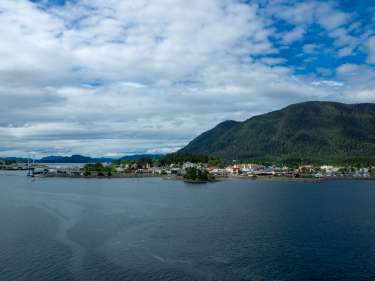
Sitka port guide.
A city that appears to have sprung up in the most unlikely of locations, Sitka is one of Alaska’s most picturesque port calls.
Its location celebrates everything that makes this otherworldly US state unique: snow-encrusted mountains, densely forested wilderness and intensely sapphire waters that radiate with glass-like shine. Yet the city is more than a basecamp for outdoor adventurers.
Sitka enjoys a blended history as diverse as its scenery. Russian, Tlingit and American settlers have all imprinted on the city. Art and culture thrive as richly as Pacific salmon here, and while small compared to other Alaskan communities, Sitka boasts countless treasures for visitors to admire.
Top landmarks and sights in Sitka.
In truth, a few hours in Sitka probably won’t feel like enough. On top of myriad outdoor pursuits, the city boasts some two dozen attractions, several of which are national landmarks.
Katlian Street is a good place to start your exploration, with cultural institutions such as Totem Square, Mariner’s Wall, Sitka Pioneer Home and the Alaska Native Brotherhood Building (ANB Hall). The area is the heart of Sitka’s Tlingit community, offering the chance to observe native dance displays alongside crossing off many of the city’s must-see sights.
On Lincoln Street you’ll also find a succession of Sitka’s Russian-era buildings, while Sitka Historical Society and Museum offers a good all-round insight into the city’s cultural evolution.
Things to do in Sitka.
With only 22 miles of paved roads, Sitka is a magnet for travelers looking to escape it all. Civilization here certainly isn’t how most visitors know it, and it’s this contrast to the bustle of modern society that lends Sitka such enduring appeal.
That being said, there’s no shortage of things to do on a port call here. Take a walking tour to discover more about the city’s history or enjoy a leisurely browse of its independent bookshops, galleries and gift shops.
Over 20 of Sitka’s buildings are on the National Register of Historic Places, including its oldest intact dwelling, the Russian Bishop’s House, constructed in 1843. This rare example of Russian colonial architecture is among just four buildings of its kind in North America, so well worth seeking out on your travels.
Sitka’s Whale Park also presents one of the best opportunities for whale spotting in Alaska. Whales are frequent visitors to shore here (as the park’s name suggests) and, as well as boardwalks leading out to sea, the grounds come equipped with binoculars to give you a fighting chance of seeing these majestic creatures up close.
Eating and drinking near Sitka cruise port.
High-quality seafood sets the bar for Sitka’s restaurants. The waters surrounding the city offer some of the best fishing in Alaska, and every year visitors descend on Sitka for a chance to hook king salmon or an infamously weighty halibut. It's little surprise then that you’ll find menus celebrating ingredients of Alaskan provenance all around town, much of which is plucked locally from land and sea.
But while the seafood here is top class, it’s not the only string to Sitka’s culinary bow. Alongside the restaurants serving five types of Pacific salmon, freshly caught crab, clams and cod, you’ll also find eateries specializing in stone-baked pizza, tacos, and organic smoothies. Perfect if seafood isn’t something you enjoy.
Some restaurants offer excellent views of the Sitka Sound and harbor, while others let you select your own shellfish from a fresh tank. If you’re in the mood for something strong with your meal, locally brewed and imported beers are served alongside international wines in most restaurants, and a steaming cup of hot coffee can be tracked down in a handful of cafés.
Shopping in Sitka.
Sitka’s shopping is a reflection of the cultures that have helped to shape the city over the years. You’ll find Russian nesting dolls sharing shelves with traditional Tlingit masks and miniature totem poles sold alongside decorative lacquer boxes in most gift shops.
Some Sitka jewelers will sell Alaskan gold nuggets as well as handcrafted silverware, while pure Alaskan salt is another proud export it’s possible to source on a port call to the city.
The ever-popular Sitka Public Market is a great one-stop-shop for souvenirs such as handmade soap and clothing, and the town’s independent liquor stores are your best bet if looking to stock-up on Alaskan beer.
Sitka culture and history.
Tlingit, Russian and wartime history abound in Sitka. If it’s the latter you’re looking for, make your way to Japonski Island, headquarters for the military forces during World War One. Connected to Sitka by the 1970’s O’Connell Road Bridge, the area is surrounded by offshore bunkers and gunning sites, which visitors can access by boat. Though time has inevitably taken its toll on the structures, the visit will resonate with anyone interested in wartime history.
The 107-acre Sitka National Historical Park is another worthwhile excursion to make while on shore, particularly if you’re keen to learn more about Sitka’s North American inhabitants. The site of Russian and Tlingit battle in 1804, the park contains a fine collection of totem poles and artifacts which you can discover on a mile-long trail walk. The area is ripe with towering trees, while a flat walking trail emerges next to a former Tlingit fort.
The Tlingit Clan House (back in town) offers yet another opportunity to deepen your appreciation of Sitka’s Tlingit settlers. Here, you’ll be treated to live re-enactments of native dance performances; a wonderful way to immerse yourself in the traditional culture of Alaska’s first people.
Sitka port facilities and location.
Cruises calling at Sitka tend to stop at the Old Sitka Cruise Terminal, located at Halibut Point Marine, unless there’s already a large ship in berth and it’s necessary to tender offshore. From port it’s just a five-mile trip into downtown Sitka and a free shuttle bus is provided to help you make the roundtrip journey to and from the terminal.
On arrival at the port you’ll find a selection of gift shops selling native Alaskan wares, as well as a large outdoor area where you can relax and watch the boats bobbing in the harbor. There’s also high-speed Wi-Fi available, perfect if you’re wanting to upload some of your Alaska cruise photos to Instagram or keep in touch with friends and family back home.
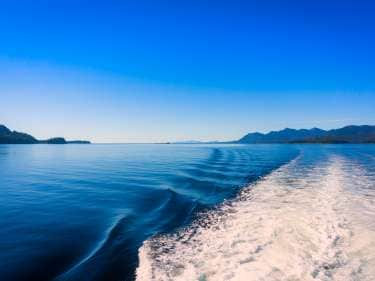
Ketchikan port guide.
Once colonized by Tlingit and Haida tribes, Ketchikan is a thriving fishing town with colorful stilted houses, a rich Alaskan culture and a throng of trawlers hauling in fresh crab and salmon.
Arts thrive here and museums celebrating the town’s history are abundant. Some of the best seafood you’ll sample in the Great Land will have been plucked directly from Ketchikan’s waters and served in its restaurants just hours later. A detail that only magnifies the appeal of this enchanting port call on your Alaska cruise.
While other towns have their origins firmly rooted in the region’s gold rush years, Ketchikan’s connection with its native population is still at the heart of its community. You’ll find Alaska’s largest collection of totem poles among its many welcoming attractions, along with heritage experiences expanding on the beliefs, customs and pastimes of Alaska’s earliest settlers.
Top landmarks and sights in Ketchikan.
Nestled among some of Alaska’s most arresting scenery, Ketchikan’s location is one to both admire and leverage. Hikers will love the trails that seem to venture out in all directions, while those who enjoy the thrill of fishing will find the waters here bountifully stocked.
Many visitors to Ketchikan use the city as a base from which to visit Misty Fjords National Monument, just 22 miles east of the city. Part of the Tongass National Forest, Misty Fjords is one of Southern Alaska’s most beautiful natural wonders, combining sheer sea cliffs, towering rock faces and expansive fjords. Seaplane offers one of the best ways to take in this magnificent scene, and is sure to provide a memorable highlight of your Alaska vacation.
Further top Ketchikan landmarks include the Deer Mountain trail (although the 2.5-mile ascent is not for the inexperienced), while the city’s infamous Creek Street, which operated as red-light district until the 1950s, is a Ketchikan institution not to be missed.
Things to do in Ketchikan Alaska.
Take in an Alaskan lumberjack show, snorkel among Ketchikan’s friendly marine life, or simply soak up the art, history and shopping in town. Ketchikan offers an abundance of entertaining activities to occupy thrill-seekers and culture enthusiasts alike.
On Creek Street, you’ll find welcoming independent galleries offering collections of native Alaskan art, as well as Dolly’s House museum where Ketchikan’s most famous resident, Dolly Arthur, once resided. Creek Street itself is populated by colorful stilt buildings jutting out of the water. It’s one of the city’s prettiest sights and a hive of local culture that lies within short walking distance of the cruise terminal.
Kayaking expeditions, guided floatplane tours and Tomcar karting in Tongass National Forest may all appeal to those looking for more adventurous pursuits in Ketchikan, while a number of fishing charters are available for guests who might like to try their hand at landing halibut or king crab.
Ketchikan also offers the chance for some exciting wildlife encounters, not least of all at its Wildlife Sanctuary and Eagle Center, where black bears, eagles and seals all reside.
Eating and drinking near Ketchikan cruise port.
The advantage of living alongside a thriving stock of freshwater salmon and crab isn’t lost on Ketchikan’s kitchens. Around half of the city’s restaurants specialize in fresh seafood and you’ll find some of the most popular establishments just a short walk from Ketchikan cruise terminal.
Freshly caught crab is a delicacy you’ll come across on countless menus, chowder (a New England and Nova Scotia favorite) offers a hearty way to warm-up with a dollop of sourdough or cornbread, while smoked and grilled fish also feature strongly among Ketchikan’s excellent seafood options.
Besides its reputation for serving up some of the freshest seafood in Alaska, Ketchikan also offers diners dishes inspired by the U.S and Canada. Pizza parlors and hamburger bars, as well as a handful of cafés selling fresh baked goods and coffees, are among the alternative choices you’ll find in Ketchikan if you’re looking to swerve fish on your visit.
Shopping in Ketchikan.
Ketchikan might not be the first place that springs to mind when you think about souvenir shopping but it’s actually a great place in Alaska to source Native crafts, canned seafood and locally made jewelry you can’t find elsewhere on your travels. In other words, if you’re looking for that cherished Alaska keepsake, Ketchikan may yet come up trumps.
It’s this nature of product that you’ll find first and foremost in the independent galleries, museums and gift shops around town, along with items that celebrate Alaska’s native heritage and history.
Where products claim to be locally made, look for the tell-tale ‘made in Alaska’ symbol to confirm this, also donated by a silver hand emblem. Ketchikan has a few souvenir shops dotted along Creek Street together with a small community shopping center on Tongass Avenue.
Ketchikan culture and history.
Ketchikan’s culture is some of the richest and most varied in Alaska, and the city has done a fantastic job in preserving the legacy of its Tlingit heritage. A port call here offers myriad ways in which to immerse yourself in this side of Alaska, not least in Ketchikan’s collection of totem poles, which is renowned for being the largest display in Alaska and one of the best examples the world over.
Purchase a combined ticket to gain entry to both the Totem Heritage Center at Ketchikan cruise port and Tongass Historical Museum, where you can experience totem poles being carved in front of your eyes, together with many fascinating exhibits expanding on Tlingit culture.
For a more interactive experience, seek out Saxman Native Village and Totem Row Park or Kasaan Totems Historic District. Both locations offer the chance to embark on a guided tour through a thriving native community and deepen your appreciation for the traditions and practices that underpin Tlingit life.
Ketchikan port facilities and location.
Ketchikan has four berths for cruise ships. Berths one and two are located on Front Street and the waterfront promenade, and are the most centrally located. Three and Four are just a few minutes’ walk into town. You’ll find a visitors’ center offering information and maps, opposite berth two. A self-guided walking tour begins from here, which you can follow at your leisure. If all four berths are occupied your ship will tender and transport you from your ship to shore by shuttle.
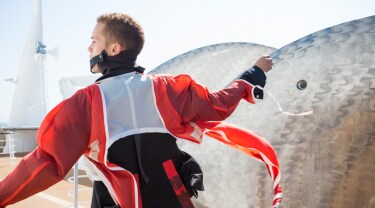
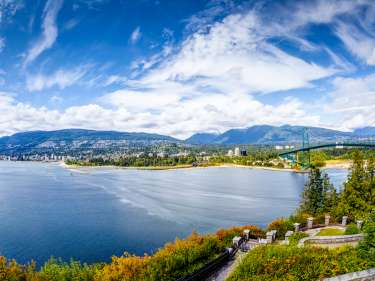
Vancouver port guide.
Consistently rated among the world’s best cities, Vancouver’s mass appeal knows no bounds. Surrounded by sea, verdant countryside and mountain peaks, the city’s position in British Columbia is an attraction in itself, but Vancouver is much more than a gateway to the Sea-to-Sky highway and the snowy slopes of Whistler.
With a dense multicultural population, the city is a diverse and cosmopolitan destination, rich with art, history and a unique culinary identity that’s gaining momentum all the time. Beyond Vancouver, you’ll find opportunities to hike, ski and kayak, as well as the chance to bathe in the world’s most mineral-dense thermal springs.
Top landmarks and sights in Vancouver.
From characterful neighborhoods like Gastown and Chinatown, to Stanley Park and the Capilano Suspension Bridge, Vancouver offers a dynamic blend of cultural and natural treasures to explore. You’ll find impressive feats of architecture and engineering, as well as adrenaline-fueled experiences to set your pulse racing.
A walk through Stanley Park is an absolute must. The 1,000-acre space is an oasis in every sense of the world, and the city’s number one attraction. Created in 1888, Stanley Park is unlike anything you’ve experienced, combining rainforest, beaches and historic landmarks with walking trails, ambient restaurants and an aquarium offering countless species of exotic fish.
In North Vancouver, The Capilano Suspension Bridge and the Grouse Mountain are among the top landmarks to seek out. The bridge snakes a 140-meter route through the treetops, 85-meters above the Capilano River. The scenery is magnificent and the experience truly unique.
Grouse Mountain, just 15-minutes from Vancouver downtown, offers an abundance of year-round attractions. Take the Skyride, North America’s largest aerial tramway, to the summit for alpine shopping, mountainside dining and ranger talks at the Refuge for Endangered Wildlife.
Things to do in Vancouver, British Columbia.
There’s no shortage of things to do on a port call to Vancouver. From museums and galleries to shopping, historical neighborhoods, and an abundance of outdoor pursuits, Vancouver is a city that really can claim to have it all.
Spend an afternoon browsing the contemporary collections at the Vancouver Art Gallery, including works by British Columbian artist Emily Carr, or enjoy the sweeping city views from the 130-meter high platform of the Vancouver Lookout at the Harbour Centre.
Vancouver’s oldest neighborhood, Gastown, offers quaint cobbled streets and some of the city’s most historic buildings (many now occupied by trendy boutiques and hip restaurants) while its Chinatown, established in the 1890s, buzzes with vibrancy and color.
Just 15 minutes from downtown Vancouver, the neighboring city of Burnaby offers the chance to explore a 1920s village, where costumed actors maintain the illusion of traveling back in time. Further afield, Whistler offers great skiing or hiking opportunities, depending on the time of year and, if time permits, the small town of Squamish is also en route and the surrounding scenery spectacular.
Harrison Hot Springs, built on the shores of Harrison Lake, is around two hours from Vancouver. The springs are among the most mineral-rich in the world and a visit to the area can be combined with a walk through Sasquatch Provincial Park.
Eating and drinking near Vancouver cruise port.
Vancouver is a multi-culturally diverse destination and nowhere is this more evident than in its culinary offer. The city is home to several outstanding restaurant districts, each with their own unique identity.
If Asian cuisine appeals, you couldn’t find yourself in a better place. Almost half of Vancouver’s residents are Asian, and consequently Japanese, Korean and Chinese restaurants are abundant in the city, the biggest concentration in Richmond and West Robson. Commercial Drive and Gastown are good all-rounders, offering a variety of excellent international restaurants.
If craft beer is your thing, Main Street offers a choice of microbreweries, alongside a good array of vegan and vegetarian eateries. If you’re looking for more casual fare, a sweet pastry or something you can eat on the go, the Granville Public Market on Granville Island has a great array of food stalls and is open daily.
Shopping in Vancouver.
If shopping appeals whilst in Vancouver, the city’s boutiques, malls and markets won’t disappoint.
Downtown Vancouver, particularly the area around Robson Street, is where you’ll find popular international brands, alongside native Canadian labels.
Gastown, Vancouver’s oldest neighborhood, is another of the city’s main shopping destinations, with a higher concentration of high-end retailers alongside stores selling antiques and First Nations art. Main Street by comparison favors more independent retail, and is the place to head if you’re looking for small boutiques and unique items.
In neighboring Burnaby, a SkyTrain ride from the city, you’ll find Metropolis at Metrotown, British Columbia’s largest shopping mall. While Granville Market, offers the chance to buy locally made crafts, art and artisanal wares, including jewelry, homewares and skincare, and is well worth a visit if you’re seeking a natively produced keepsake to remind you of your time in Vancouver.
Vancouver culture and history.
One of the most wonderful things about Vancouver is its history.
Spanish, Japanese, Chinese, Italian and Indian migrants have all shaped the city, resulting in a harmonious melding of cultural influences. You’ll notice streets named after Spanish settlers who arrived in the 17th Century, while Spanish Banks, one of Vancouver’s loveliest beaches, honors the place where Captain George Vancouver met with Spanish Captains, Valdez and Galiano, in 1792.
Vancouver’s tea houses and cherry trees can be traced back to arrival of Japanese immigrants in the late 1800s, while the city’s Chinatown began with the Chinese workers who came to labor on the railroads and in Vancouver’s mines. Vancouver’s burgeoning lumber industry later attracted Indian workers, whose presence can still be felt in the six blocks around Main Street known as Punjabi Market or little India. Italians then followed after World War II, creating a community anchored around Commercial Drive that still lays claim to Vancouver’s best espresso bars.
Other notable moments in Vancouver’s history include Houdini suspending himself from the city’s Sun Tower in 1920 and Elvis Priestly singing at Vancouver’s Empire Stadium in 1957. More recently, Vancouver has become a popular filming destination, resulting in the city being dubbed ‘Hollywood North’ while its hosting of the 2010 Winter Olympic Winter Games saw Canada proudly take home a gold medal in the men’s hockey.
Vancouver port facilities and location.
Vancouver’s cruise terminal, Canada Place, is conveniently located near the city’s downtown, with many shops, restaurants and noteworthy attractions within walking distance.
Flyover Canada, a state of the art flight simulator that incorporates wind and other immersive effects, can be found in Canada Place, while shuttle busses and taxis are available to take you where you want to go.
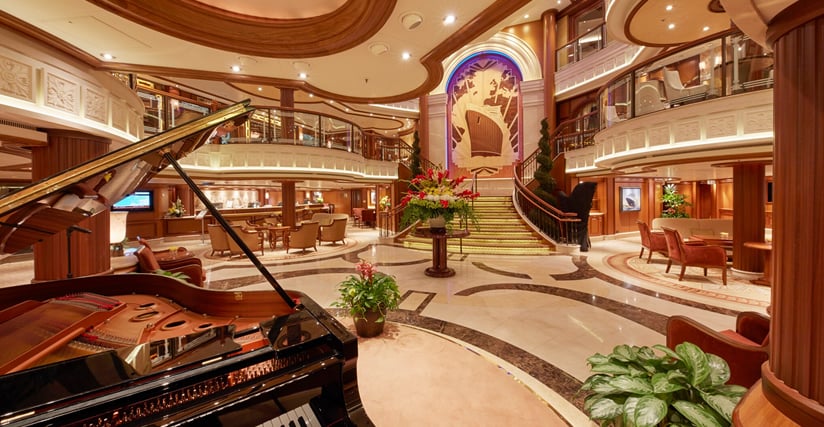
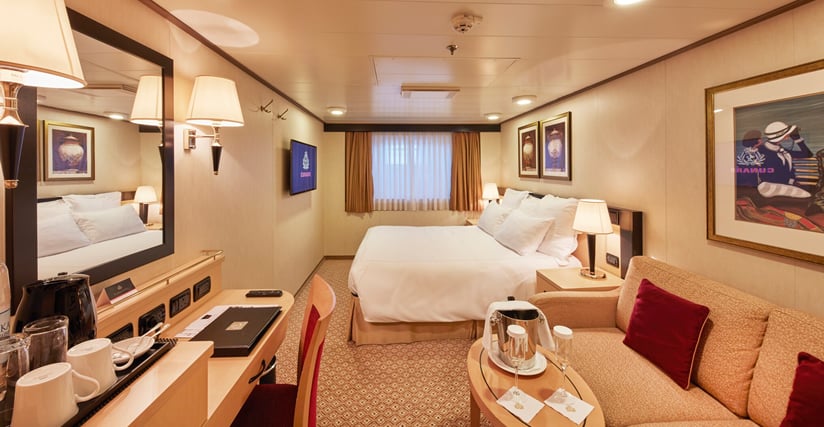

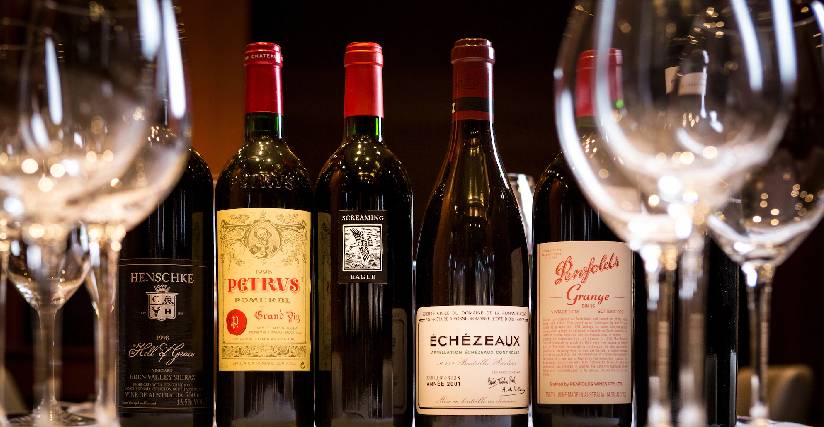

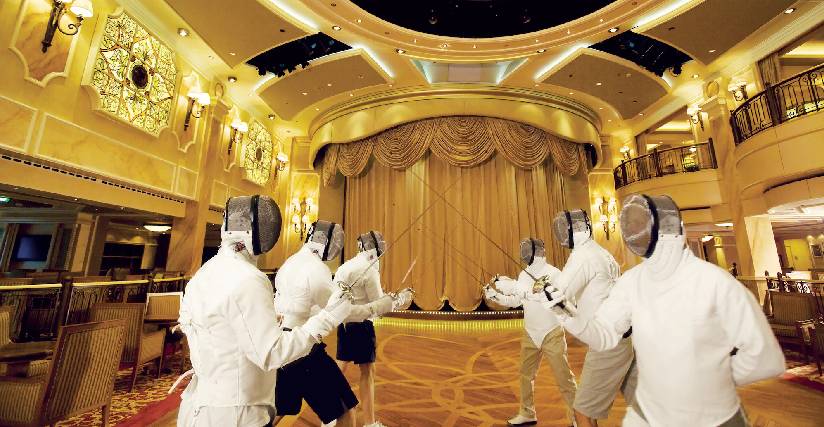
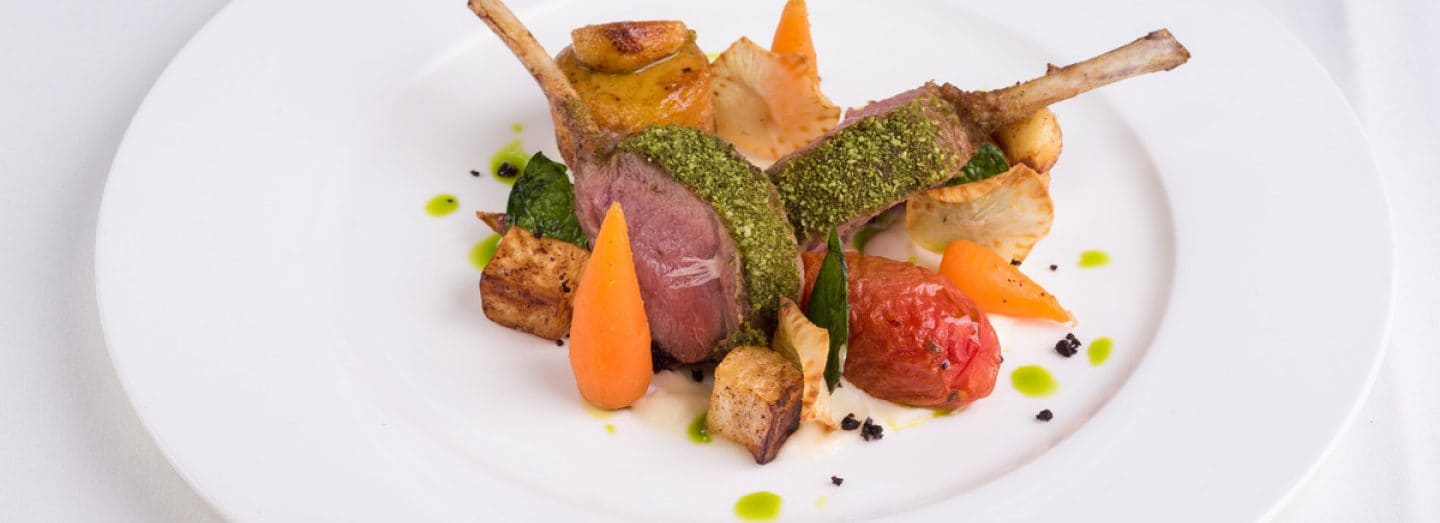
You’ll enjoy a sense of freedom regarding the array of places to eat, from hearty to healthy, light bites to fine dining.

On board each Cunard Queen, in the exclusive comfort of Cunard's Grill Suites you will experience the very best, embodied by Cunard signature traits: attentive service, and even more space to relax in luxury.

Do as much or as little as you please—it’s your choice. Choose blissful relaxation or from myriad experiences to learn a new skill, broaden your mind or fill your day with activity.
Limited-time Offer. Advertised prices in CAD per person and based on double occupancy. New bookings only and may not be combinable with other offers and promotions. **Savings are “up to”, per couple based on double occupancy and included in advertised fares. Gov’t taxes & fees included.
Economy Roundtrip Air is from select Canadian gateways. Low air add-on available for other gateways. Call for details. Some airline-imposed personal charges, including but not limited to baggage, priority boarding, and special seating, may apply.
Transfers are extra charges unless otherwise noted. Call for details
Some Oceanview and Balcony/Veranda staterooms may have obstruction views. Call for details.
Shipboard Credits are per stateroom and apply to select cruise lines, select voyages and based on length of voyage and stateroom category. Call for details.
Perks (Drinks, prepaid gratuities, specialty dining are based on 1st and 2nd guests in a stateroom). Perks apply to select cruise lines and may vary per cruise line. Call for details.
‡Travel Insurance (Trip Cancellation & Trip Interruption) is group insurance administered by Travel Guard Group Canada, Inc. and underwritten by AIG Insurance Company of Canada. The Summary of Coverage contains reductions, limitations, exclusions, termination provisions and sanction wording. The cost of the insurance is included in the price of the cruise, and the price cannot be reduced for those who reside where coverage is not available or who are not medically able to travel. Emergency medical coverage is available at additional cost. Travel insurance included is not available to residents of Quebec.
‡Travel Insurance (Trip Cancellation & Trip Interruption) applies to Club Balcony & higher stateroom categories for select cruise lines and select voyages. Call for details.
Cruise line reserves the right to charge a fuel supplement without prior notice, including on fully paid bookings. All offers, rates & sailings subject to change & availability at time of booking. Promotion is capacity controlled and may be pulled out at any time without prior notice. Certain restrictions apply.
Cruise Connections reserves the right to correct errors & omissions. BPCPA #28364.

